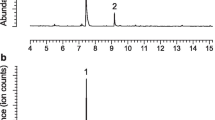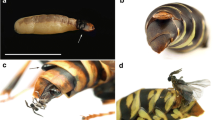Abstract
Capillary gas chromatography with columns of different polarity and two-dimensional fractionation of effluents were used with novel subtrac-tive-combination bioassays to rigorously isolate host- and insect-produced pheromone synergists of the bark beetlePityogenes chalcographus (Coleop-tera: Scolytidae). Methyl (E,Z)-2,4-decadienoate (E,Z-MD) and the previously identified chalcogran were found to be synergistically attractive to both sexes.E,Z-MD was produced sex-specifically in males, and only when they had fed on host-plant tissue. A Norway spruce monoterpene fraction (including α-pinene, β-pinene, and camphene) increased the attractive response to the pheromone components. Dose-response curves forE,Z-MD and chalcogran in the laboratory bioassay indicated the two components are highly synergistic. The isolation methods are important for further progress in identifying certain semiochemical synergists found in trace amounts in complex chemical mixtures, such as when insects must feed in host plants in order to produce pheromone.
Similar content being viewed by others
References
Anderbrant, O.,Byers, J.A.,Jirle, E.,Jönsson, J.,Löfqvist, J., andSchlyter, F. 1990. Continuous rearing and automatic collection of some European spruce bark beetles.J. Appl. Entomol. Submitted.
Baader, V.E.J. 1989.Pityogenes spp. (Col., Scolytidae): Utersuchungen über verhaltenssteuernde Duftstoffe und deren Anwendung im Waldschutz.J. Appl. Entomol. 107:1–31.
Berenbaum, M., andNeal, J.J. 1985. Synergism between myristicin and xanthotoxin, a naturally cooccurring plant toxicant.J. Chem. Ecol. 11:1349–1358.
Birgersson, G., Schlyter, F., Löfqvist, J., andBergström, G. 1984. Quantitative variation of pheromone components in the spruce bark beetleIps typogmphus from different attack phases.J. Chem. Ecol. 10:1029–1055.
Birgersson, G.,Byers, J.A.,Bergström, G., andLöfqvist, J. 1990. Production of pheromone components chalcogram and methyl (E,Z)-2,4-decadienoate, in the spruce engraver,Pityogenes chalcographus. J. Insect Physiol. Submitted.
Boou, C.J.H., andVoerman, S. 1985. New lepidopteran sex attractants found by systematic field screening of blends containing (Z)-11- and (E)-11-tetradecenal.J. Chem. Ecol. 11:1333–1339.
Borden, J.H., Chong, L., McLean, J.A., Slessor, K.M., andMori, K. 1976.Gnathotrichus sulcatus: Synergistic response to enantiomers of the aggregation pheromone sulcatol.Science 192:894–896.
Burger, B.V., Munro, Z., Röth, M., Spies, H.S.C., Truter, V., Geertsema, H., andHabich, A. 1985. Constituents of osmeterial secretion of pre-final instar larvae of citrus swallowtail;Papilio demodocus (Esper) (Lepidoptera: Papilionidae).J. Chem. Ecol. 11:1093–1113.
Byers, J.A. 1989. Chemical ecology of bark beetles.Experientia 45:271–283.
Byers, J.A., Wood, D.L., Craig, J., andHendry, L.B. 1984. Attractive and inhibitory pheromones produced in the bark beetle,Dendroctonus brevicomis, during host colonization: Regulation of inter- and intraspecific competition.J. Chem. Ecol. 10:861–877.
Byers, J.A., Lanne, B.S., Schlyter, F., Löfqvist, J., andBergström, G. 1985. Olfactory recognition of host-tree susceptibility by pine shoot beetles.Naturwissenschaften 72:324–326.
Byers, J.A., Birogrsson, G., Löfqvist, J., andBergström, G. 1988. Synergistic pheromones and monoterpenes enable aggregation and host recognition by a bark beetle.Naturwissenschaften 75:153–155.
Byers, J.A., Högberg, H.E., Unelius, C.R., Birgersson, G., andLöfqvist, J. 1989. Structure-activity studies on aggregation pheromone components ofPityogenes chalcographus (Coleop-tera: Scolytidae): All stereoisomers of chalcogran and methyl 2,4-decadienoate.J. Chem. Ecol. 15:685–695.
Chen, E.C.M. 1979. Selective ion monitoring, p. 127–149,in B.S. Middleditch (ed.). Practical Mass Spectrometry—A Contemporary Introduction. Plenum Press, New York.
Chuman, T., Mochizuki, K., Mori, M., Kohno, M., Kato, K., andNoguchi, N. 1985.Lasioderma chemistry sex pheromone of cigarette beetle (Lasioderma serricorne F.).J. Chem. Ecol. 11:417–434.
Deans, D.R. 1981. Use of heart cutting in gas chromatography: A review.J, Chromatogr. 203:19–28.
Dicke, M., Van Lenteren, J.C., Boskamp, B.J.F., andVan Voorst, R. 1985. Intensification and prolongation of host searching inLeptophilina heteroloma (Thomson) (Hymenoptera: Eucoilidae) through a kairomone produced byDrosophila melanogaster.J. Chem. Ecol. 11:125–136.
Doss, R.P., andShanks, C.H., Jr. 1984. Black vine weevil,Otiorhynchus sulcatus (Coleoptera: Curculionidae), phagostimulants from “alpine” strawberry.Environ. Entomol. 13:691–695.
Garland, W.A., andPowell, M.L. 1981. Quantitative selected ion monitoring (QSIM) of drugs and/or metabolites in biological matrices.J. Chromatogr. Sci. 19:392–434.
Francke, W., Heemann, V., Gerken, B., Renwick, J.A.A., andVité, J.P. 1977. 2-Ethyl-1,6-dioxaspiro[4,4]nonane, principal aggregation pheromone ofPityogenes chalcographus (L.).Naturwissenschaften 64:590–591.
Hanula, J.L., Berisford, C.W., andDebarr, G.L. 1985. Monoterpene oviposition stimulants ofDioryctria amatella in volatiles from fusiform rust galls and second-year loblolly pine cones.J. Chem. Ecol. 11:943–952.
Heath, R.R., Coffelt, J.A., Sonnet, P.E., Proshold, F.I., Dueben, B., andTumlinson, J.H. 1986. Identification of sex pheromone produced by female sweetpotato weevil,Cylas formicarius elegantulus (Summers).J. Chem. Ecol. 12:1489–1503.
Jackson, D.M., Severson, R.F., Johnson, A.W., Chaplin, J.F., andStephenson, M.G. 1984. Ovipositional response of tobacco budworm moths (Lepidoptera: Noctuidae) to cuticular chemical isolates from green tobacco leaves.Environ. Entomol. 13:1023–1030.
Kim, M., Koh, H.-S., andFukami, H. 1985. Isolation ofC-glycosylflavones as probing stimulant of planthoppers in rice plant.J. Chem. Ecol. 11:1–9.
Kirk, W.D.J. 1985. Effect of some floral scents on host finding by thrips (Insecta: Thysanoptera).J. Chem. Ecol. 11:35–43.
Lanne, B.S., Schlyter, F., Byers, J.A., Löfqvist, J., Leufvén, A., Bergström, G., Van Der Pers, J.N.C., Unelius, R., Baeckström, P., andNorin, T. 1987. Differences in attraction to semiochemicals present in sympatric pine shoot beetles,Tomicus minor andT. piniperda.J. Chem. Ecol. 13:1045–1067.
Löfstedt, C., andVan Der Pers, J.N.C. 1985. Sex pheromones and reproductive isolation in four European small ermine moths.J. Chem. Ecol. 11:649–666.
Löfstedt, C., Van Der Pers, J.N.C., Löfqvist, J., Lanne, B.S., Appelgren, M., Bergström, G., andThelin, B. 1982. Sex pheromone components of the turnip mothAgrotis segetum: Chemical identification, electrophysiological evaluation, and behavioral activity.J. Chem. Ecol. 8:1305–1321.
Löfstedt, C., Linn, C.E., Jr., andLöfqvist, J. 1985. Behavioral responses of male turnip moths,Agrotis segetum, to sex pheromone in a flight tunnel and in the field.J. Chem. Ecol. 11:1209–1221.
Maeshima, K., Hayashi, N., Murakami, T., Takahashi, F., andKomae, H. 1985. Identification of chemical oviposition stimulants from rice grain forSitophilus seamais Motschulsky (Coleoptera, Curculionidae).J. Chem. Ecol. 11:1–9.
McKibben, G.H., Thompson, M.J., Parrott, W.L., Thompson, A.C., andLusby, W.R. 1985. Identification of feeding stimulants for boll weevils from cotton buds and anthers.J. Chem. Ecol. 11:1229–1238.
Millar, J.G., Pierce, H.D., Jr., Pierce, A.M., Oehlschlager, A.C., Borden, J.H., andBarak, A.V. 1985. Aggregation pheromones of the flat grain beetle,Cryptolestes pusillus (Coleoptera: Cucujidae).J. Chem. Ecol. 11:1053–1070.
Norman, C. 1985. AIDS therapy: New push for clinical trials.Science 230:1355–1358.
Pearce, G.T., Gore, W.E., Silverstein, R.M., Peacock, J.W., Cuthbert, R.A., Lanier, G.N., andSimeone, J.B. 1975. Chemical attractants for the smaller European elm bark beetle,Scolytus multistriatus (Coleoptera: Scolytidae).J. Chem. Ecol. 1:115–124.
Roelofs, W.L., andCardé, R.T. 1977. Responses of Lepidoptera to synthetic sex pheromone chemicals and their analogues.Annu. Rev. Entomol. 22:377–405.
Schurig, V., andWeber, R. 1984. Use of glass and fused-silica open tubular columns for the separation of structural, configurational and optical isomers by selective complexation gas chromatography.J. Chromatogr. 289:321–332.
Silk, P.J., Kuenen, L.P.S., Tan, S.H., Roelofs, W.L., Sanders, C.J., andAlford, A.R. 1985. Identification of sex pheromone components of jack pine budworm,Choristoneura pinus pinus Freeman.J. Chem. Ecol. 11:159–167.
Silverstein, R.M. 1981. Pheromones: Background and potential for use in insect pest control.Science 213:1326–1332.
Silverstein, R.M., andYoung, J.C. 1976. Insects generally use multi-component pheromones. p. 1–29,in M. Beroza (ed.). Pest Management with Insect Sex Attractants and Other Behavior-Controlling Chemicals. American Chemical Society Symposium Series 23, Washington, D.C.
Silverstein, R.M., Rodin, J.O., Wood, D.L., andBrowne, L.E. 1966. Identification of two new terpene alcohols from frass produced byIps confusus in ponderosa pine.Tetrahedron 22:1929–1936.
Silverstein, R.M., Rodin, J.O., andWood, D.L. 1967. Methodology for isolation and identification of insect pheromones with reference to studies on California five-spinedIps.J. Econ. Entomol. 60:944–949.
Silverstein, R.M.,Brownlee, R.G.,Bellas, T.E.,Wood, D.L., andBrowne, L.E. 1968. Brevicomin: Principal sex attractant in the frass of the female western pine beetle.
Smith, A.B., III, Belcher, A.M., Epple, G., Jurs, P.C., andLavine, B. 1985. Computerized pattern recognition: A new technique for the analysis of chemical communication.Science 228:175–177.
Smith, B.H., Carlson, R.G., andFrazier, J. 1985. Identification and bioassay of macrocyclic lactone sex pheromone of the halictine beeLasioglossum zephyrum.J. Chem. Ecol. 11:1447–1456.
Stubbs, M.R., Chambers, J., Schofield, S.B., andWilkins, J.P.G. 1985. Attractancy toOryzaephilus surinamensis (L.) of volatile materials isolated from vacuum distillate of heat-treated carobs.J. Chem. Ecol. 11:565–581.
Teal, P.E.A., Mitchell, E.R., Tumlinson, J.H., Heath, R.R., andSugie, H. 1985. Identification of volatile sex pheromone components released by the southern armyworm,Spodoptera eridania (Cramer).J. Chem. Ecol. 11:717–725.
Vanderwel, D., andOehlschlager, A.C. 1987. Biosynthesis of pheromones and endocrine regulation of pheromone production in Coleoptera, pp. 175–215,in G.D. Prestwich and G.J. Blomquist (eds.). Pheromone Biochemistry. Academic Press, New York.
Vité, J.P., andRenwick, J.A.A. 1970. Differential diagnosis and isolation of population attractants.Contrib. Boyce Thompson Inst. 24:323–328.
Vité, J.P., Bakke, A., andRenwick, J.A.A. 1972. Pheromones inIps (Coleoptera; Scolytidae): Occurrence and production.Can. Entomol. 104:1967–1975.
Wassgren, A.-B., andBergström, G. 1984. Revolving fraction collector for preparative capillary gas chromatography in the 100-μg to 1-ng range.J. Chem. Ecol. 10:1543–1550.
Author information
Authors and Affiliations
Rights and permissions
About this article
Cite this article
Byers, J.A., Birgersson, G., Löfqvist, J. et al. Isolation of pheromone synergists of bark beetle,Pityogenes chalcographus, from complex insect-plant odors by fractionation and subtractive-combination bioassay. J Chem Ecol 16, 861–876 (1990). https://doi.org/10.1007/BF01016496
Received:
Accepted:
Issue Date:
DOI: https://doi.org/10.1007/BF01016496




